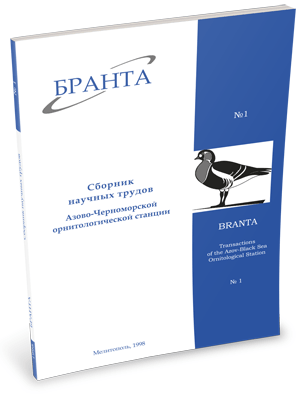
Transactions
of the Azov-Black Sea Ornithological Station



Post-breeding gatherings and migration of waders on the eastern coast of Baydaratskaya bay
Chemichko J.I., Gromadzkiy М., Diadicheva E.A., Grinchenko A.B.
The study area was situated near estuary of Enzoryakha river and on the coast of Baydaratskaya bay (Kara Sea; 68.34E 68.17N). From 24 July to 23 August 1992 migration routes of waders (mainly sandpipers) in the Eastern Europe were studied at this location. Regular censuses of waders on fixed counting routes (8 and 4 km long, total length 256 km), episodic counts, observations on the migration (once within 3 days’ period, 29.3 hours in total) and mist-netting were used. 4 types of biotopes were distinguished along the counting routs: (1) intertidal flats; (2) river sandbanks; (3) “lydes ” - boggy tundra zones with small lakes and (4) “seashoreglades” - narrow coastal zones with grassy vegetation. In total 41700 individuals of 17 species were censused.
Character and completeness (representativeness) of collected material. 60% of the total number of species known for this region were recorded. Representativeness ofcounts along the fixed route (percentage of waders counted along fixed route out of the total number recorded during the whole study period) was maximum for species attracted to large gatherings or to certain biotopes
and lowfor species equally occurring in different biotopes (Phalaropus lobatus, Calidris temminckii, Philomachus pugnax).
Discussion of results. Features of migration and distribution of some species. Mean numbers of some wader species over 1 counting day, peaks of numbers, dynamics and directions of migration (Table3), preferable biotopes (Table 1) are analysed. For the species which were caught in mist-nets age composition, average body mass and moult score were also evaluated. Calidris minuta and Calidris alpina were the most numerous in wader gatherings; Charadrius hiaticula, Phalaropus lobatus, Philomachuspugnax were the numerous species; Pluvialis squatarola, Calidris temminckii, Calidris alba, Calidris ferruginea the common species; Pluvialis fulva, Pluvialis apricaria, Tringa glareola, Tringanebularia, Tringa erythropus, Arenaria interpres, Calidris canutus, Gallinago gallinago the least numerous.
Mixed gatherings and their composition analysis. 31.8% of the total numbers of waders counted were recorded in mixed gatherings; participation in gatherings and sociality of certain species are shown in Table2. Two problems are discussed: (1) possibility of forming mixed flocks in quite distant from Baydaratskaya bay areas and their further migration as relatively constant units; (2) role of the different biotopes in formation of premigratory flocks. Most of mixed flocks (75%) included 8-200 individuals of 2-3 species; only some flocks consisted of more than 1000 individuals and of 5-6 species. Mixed flocks were formed mainly by most numerous species: Calidris minuta (68%) and Calidris alpina (62%); Calidris ferruginea and Calidris alba appeared to be the most social species. First of all the sea coast and also river shallows play the leading role in the formation of premigratory gatherings.
Discussion of migrations.Wader migration at the Baydaratskaya bay coast took place in later terms thanit was described for example at the White Sea coast. Peak of the migration of Calidris alpina and Philomachus pugnax seemed to be at the end of August or even later. As far as we can see it on the example of the target species it may be assumed that the migrants move from the Baydaratskaya bay area following the continental flyway and avoid the Baltic Sea coast. An analysis of number dynamics of all species shows that general peaks of migration took place on 3, 17, 20 August. Directions in which of some species migrated and the most frequent flight directions are shown in Table 3 and Figure 6, where southern direction is clearly prevalent. It is supposed that southern part of Baydaratskaya bay is the start area for waders using continental flyway towards the Ob river and more southerly.
Read the paper in a PDF file